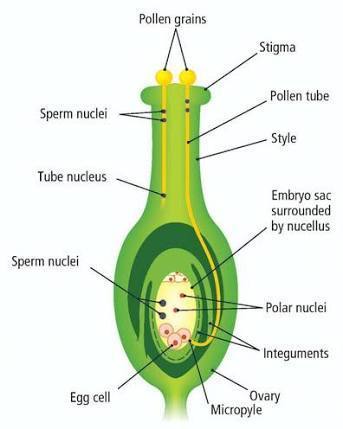Fertilization
Pollination is followed by Fertilization in Plants.
Fertilization is the process of fusion of male germ cells with the female gametes. It gives rise to a zygote. As soon as the pollen lands on suitable stigma, it reaches the female cells in the ovary. This occurs via a pollen tube. The pollen tube grows out of the pollen grain, travels through the style and finally reaches the ovary.

In flowering plants
- The pollen grain produces two male gametes.
- The ovule inside the ovary produces the female gamete.
Also Check – How do Organisms Reproduce Class 10 -Notes
The Pollen Grain
The mature pollen grain is a cell with a double wall the outer exine and the inner intine. Its nucleus has already divided into a tube nucleus and a generative (male) nucleus. At this stage, the pollen is transferred to stigma i.e.Pollination. Further changes in pollen grain occur only if it has fallen on the stigma of a plant of the same species.
The Ovule
Ovule is the inner part of the ovary. Ovule is destined to become the seed and the ovary to
become the fruit containing the seed inside. Ovary can be a single ovule producing a single-seeded fruit or many ovules producing a many-seeded fruit.
Each ovule has one or two protective coverings,the integuments. The integuments leave a small opening called the micropyle at one end (for the entry of pollen tube).
Enclosed by the integuments is the nucellus (a mass of food-laden cells), and further inside the
nucellus is the embryo sac.
The embryo sac contains seven cells :
- 3 cells at the micropylar end- one egg cell and two synergids.
- 3 cells at opposite end, called antipodal cells.
- 1 large central cell. The central cell contains two nuclei (called polar nuclei) fused together.
Also Check – How is the process of Pollination diffrent from Fertilization
Germination of Pollen Grain

Pollen grain germinates only if it falls on the stigma of the same plant species, otherwise, it disintegrates.
The pollen grain on falling on the stigma is stimulated to germinate due to the secretion of sugars by the stigma.
Through a point in the exine, a pollen tube grows out of the pollen grain, carrying at its tip the generative nucleus and the tube nucleus, generative nucleus divides into two sperm nuclei (also called male gamete nuclei).
Thus in a germinating pollen grain, there are three nuclei which are not separated by cell walls, they share a common cytoplasm.
The pollen tube grows through the stigma and style by dissolving the tissues with the help of enzymes and reaches the ovary. There, it pushes through the micropyle and reaches the embryo sac.
The tube nucleus which had directed the growth of the pollen tube all the way down, now disintegrates.
What is double Fertilization ?
The pollen tube enters one of the synergids and releases its two sperm nuclei. Of these, one sperm nucleus fuses with the egg cell nucleus to form the zygote while the other sperm nucleus moves towards the two polar nuclei in the central cell and fuses with them (thus 3 nuclei fuse together/triple fusion to produce the endosperm nucleus). All together two fertilizations have occurred and hence the whole process is termed double fertilization.
Also Check-How do Organisms Reproduce Class 10 -Notes
In Double fertilisation:-
1. One sperm nucleus fuses with the egg cell nucleus.
2. The other sperm nucleus fuses with the two polar nuclei of the central cell.
Floral parts after Fertilization.
- After fertilization the flower has served its purpose. The petals, stamens, style and stigma wither and generally fall off.
- The calyx may either fall off or may remain intact in a dried and shriveled form. Apple and guava clearly show such dried sepals. In brinjal, green calyx persists and remains attached to the ripe fruit.
- The ovary enlarges to form fruit, the ovarian wall forming the fruit wall. The ovary wall may either form a dry and hard fruit wall or a fleshy fruit wall.
- Ovules become the seeds. The fruit contains one or more seeds which are developed from one or more ovules attached to the ovary by means of placenta(e). When the fruit is ripe, the seeds contained inside are released by one or the other method and grow into new plants in suitable conditions.


6 Comments on “What is Fertilization Class 10”